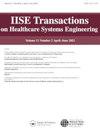医生安排跨多个设施的紧急远程医疗
IF 1.5
Q3 HEALTH CARE SCIENCES & SERVICES
IISE Transactions on Healthcare Systems Engineering
Pub Date : 2023-04-13
DOI:10.1080/24725579.2023.2201481
引用次数: 0
摘要
摘要远程医疗已成为远程连接医疗服务提供者和患者的有效手段。在急救方面,远程医疗通常涉及远程医疗服务中心(TSH),该中心将远程医生与急诊病房的患者进行匹配。此类系统的有效运行需要医生和当地医疗机构之间的谨慎和持续协调,因此,医生的人员配置和日程安排是TSH必须克服的主要管理挑战。在这种情况下,我们的论文研究了一种环境,在这种环境中,TSH必须在相当短的时间窗口内指派一名医生来应对即将到来的紧急病例。一个机构的急诊病例只能与该机构有资质的医生匹配。由于护理是紧急的,当没有值班医生时,排队的病人是不可选择的。在这种情况下,系统必须调用下班医生,这被称为“爆炸”。由于成本高昂,远程医疗公司试图避免这种选择。我们提出了一种新的整数规划模型,用于生成多家医院的医生时间表,该时间表具有证书和覆盖范围的最佳组合。所提出的模型旨在最大限度地减少在机会约束下的总成本,该约束限制了爆炸概率和该环境特有的其他战术约束。针对实际尺寸问题,提出了两种基于启发式的快速求解方法,并通过数值分析验证了它们的计算性能。本文章由计算机程序翻译,如有差异,请以英文原文为准。
Physician scheduling for emergency telemedicine across multiple facilities
Abstract Telemedicine has emerged as an effective means to connect health service providers with patients remotely. In the context of emergency care, telemedicine typically involves a telemedicine service hub (TSH) that matches remote physicians with patients in emergency wards. Effective operation of such systems requires careful and continuous coordination between physicians and local providers and as such, physician staffing and scheduling is a major managerial challenge that a TSH has to overcome. In this context, our paper studies a setting, where the TSH must respond to an arriving emergency case by assigning a physician within a considerably short time window. An emergency case at a facility can be matched only with a physician who is credentialed at that facility. Since care is urgent, queuing patients is not an option when there is no available on-shift physician. In such cases, the system must invoke the off-shift physicians, which is referred to as “blast.” The telemedicine company tries to avoid this option due to high costs. We propose a novel integer programming model for generating physician schedules with optimal mix of credentials and coverage across multiple hospitals. The proposed model aims to minimize total costs under a chance constraint that limits the blast probabilities and other tactical constraints that are unique to this setting. Two fast acting heuristic-based solution approaches are developed for real-life size problems and their computational performances were demonstrated via numerical analyses.
求助全文
通过发布文献求助,成功后即可免费获取论文全文。
去求助
来源期刊

IISE Transactions on Healthcare Systems Engineering
Social Sciences-Safety Research
CiteScore
3.10
自引率
0.00%
发文量
19
期刊介绍:
IISE Transactions on Healthcare Systems Engineering aims to foster the healthcare systems community by publishing high quality papers that have a strong methodological focus and direct applicability to healthcare systems. Published quarterly, the journal supports research that explores: · Healthcare Operations Management · Medical Decision Making · Socio-Technical Systems Analysis related to healthcare · Quality Engineering · Healthcare Informatics · Healthcare Policy We are looking forward to accepting submissions that document the development and use of industrial and systems engineering tools and techniques including: · Healthcare operations research · Healthcare statistics · Healthcare information systems · Healthcare work measurement · Human factors/ergonomics applied to healthcare systems Research that explores the integration of these tools and techniques with those from other engineering and medical disciplines are also featured. We encourage the submission of clinical notes, or practice notes, to show the impact of contributions that will be published. We also encourage authors to collect an impact statement from their clinical partners to show the impact of research in the clinical practices.
 求助内容:
求助内容: 应助结果提醒方式:
应助结果提醒方式:


